Introduction: The Power of Strategy in Product Launch Events
In the competitive global marketplace, a product launch is no longer just an announcement—it’s a critical moment of brand definition, market positioning, and revenue generation. Especially in a dynamic hub like Singapore, where innovation is constant, standing out requires more than just a memorable party; it requires a bulletproof strategy.
A leading event planning company Singapore understands that the difference between a high-impact launch and a forgettable one lies in the foundational frameworks used during the planning process. These frameworks transform mere logistics into strategic brand experiences, ensuring every dollar spent contributes directly to core business objectives.
This deep-dive guide explores the seven essential strategic frameworks that Singapore’s top event planners employ to guarantee their clients’ product launches resonate, generate buzz, and ultimately drive significant ROI. If you are preparing to introduce your next big thing, understanding these methodologies is the first step toward a launch event that truly defines success.
See More: The Ultimate List of Event Management Companies in Singapore (2025 Guide)
Why Frameworks Matter for Product Launches
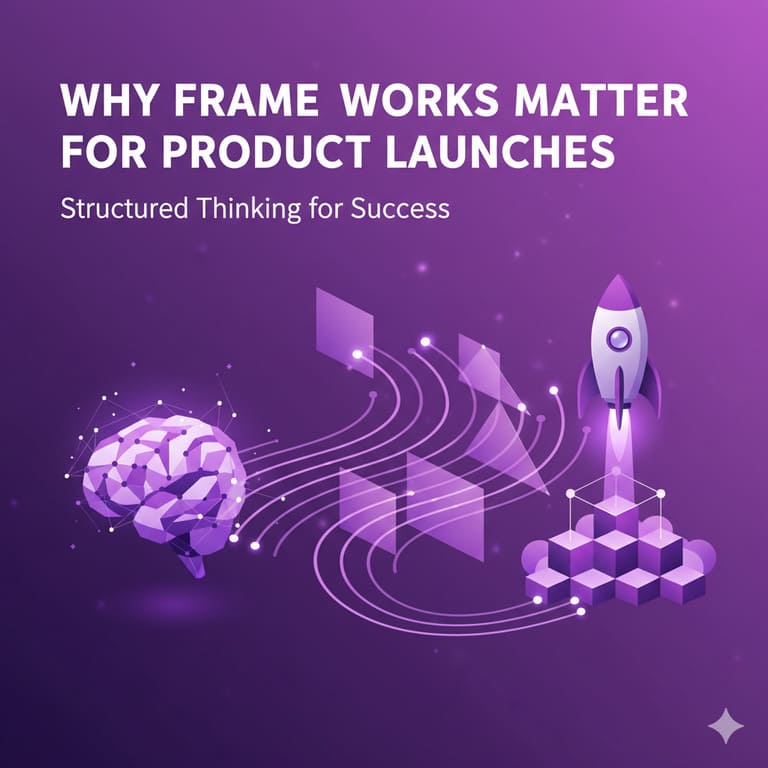
A product launch is often the largest marketing investment a company makes. Without a clear strategic framework, planners risk focusing solely on aesthetics (the ‘fluff’) while overlooking the core business goals (the ‘stuff’).
A robust framework provides:
- Alignment: Ensures every element of the event—from the keynote speaker to the coffee break—supports the product’s unique selling proposition (USP) and the company’s Q-on-Q objectives.
- Mitigation: Proactively identifies and reduces risks (technical, logistical, or communicative) that could derail the launch message.
- Measurement: Establishes clear, quantifiable metrics for success before the event even begins.
Top event planning company Singapore utilize these 7 frameworks to move beyond execution and into strategic partnership.
1. The Goal-Oriented (G-O-A-L) Framework for Product Launches
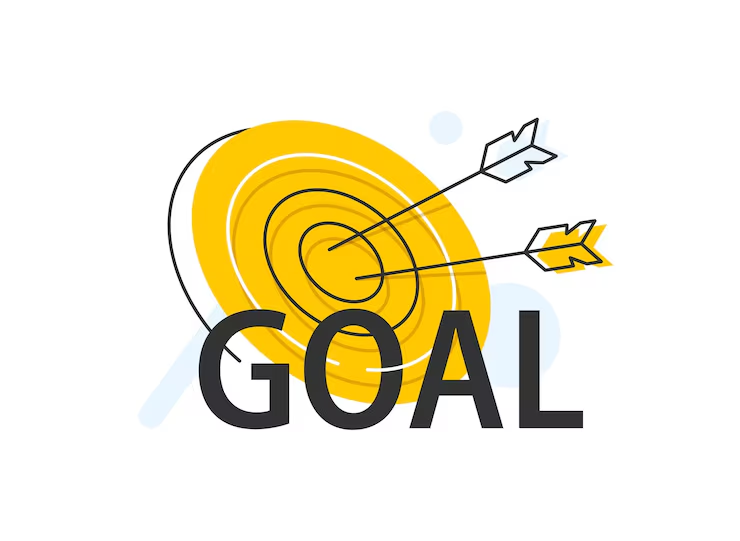
The G-O-A-L framework ensures that the event’s purpose is surgically precise, moving beyond vague objectives like “increase brand awareness.”
| G-O-A-L Element | Strategic Focus | Example Metric |
| Gain (Acquisition) | Customer or partner acquisition (e.g., securing first 100 enterprise leads). | Number of qualified leads generated through event registration/app. |
| Outcome (Behavioral) | Specific attendee action (e.g., immediate product trial sign-ups, demo bookings). | Percentage of attendees who complete the on-site product demo. |
| Alignment (Internal/Brand) | Ensuring internal teams/media understand the core positioning and narrative. | Post-event internal survey on clarity of messaging; Media mentions focusing on USP. |
| Leverage (Future Value) | Content creation, future sales pipeline, or community building. | Total social media impressions; Pipeline value attributed to event attendees. |
A Singapore event planner using this framework starts with the desired business outcome (e.g., a 15% increase in market share) and reverse-engineers the event design to achieve it.
See More: 7 Ways an Event Management System Boosts Attendee Engagement (A 2025 Guide)
2. The 5 C’s of Experiential Design Framework
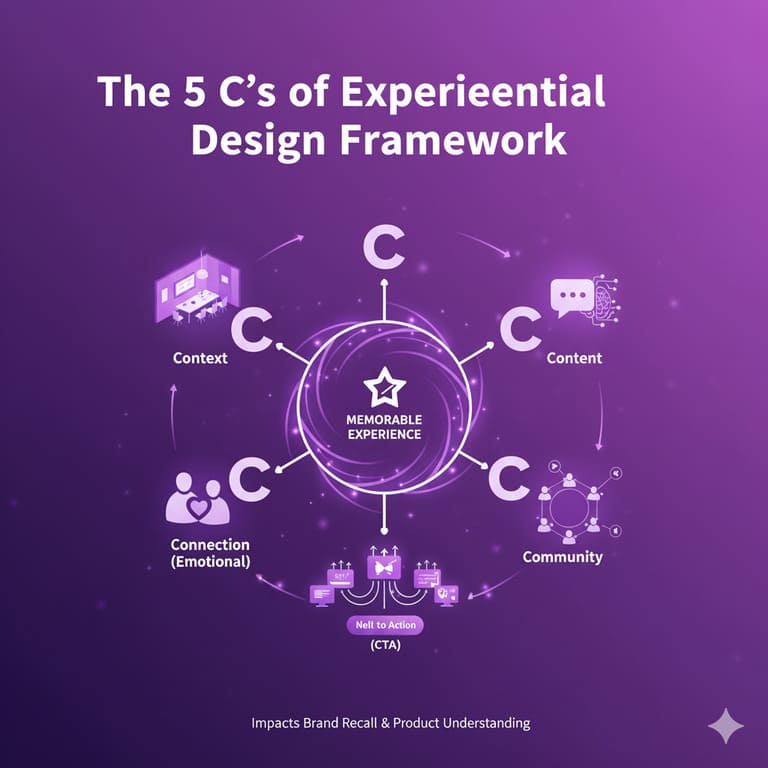
This framework is critical for transitioning from a passive presentation to an active, memorable experience, directly impacting brand recall and product understanding—a specialty of any premium event planning company Singapore.
- Context: Ensuring the event environment (venue, theme, ambiance) naturally supports the product’s function and target audience. (E.g., A B2B software launch is held in a minimalist, collaborative space, not a loud ballroom.)
- Content: The narrative and information delivered must be concise, emotionally resonant, and immediately relevant to the audience’s pain points.
- Connection (Emotional): Creating moments that foster genuine emotional ties between the attendee and the brand/product. (E.g., Using personalized AR/VR experiences demonstrating the product’s impact on their job.)
- Community: Designing interactive segments that encourage attendees to network and share their excitement, turning them into brand advocates.
- Call to Action (CTA): Providing clear, multi-channel paths for attendees to take the next step immediately following the experience.
3. The Product Story Arc (PSA) Framework
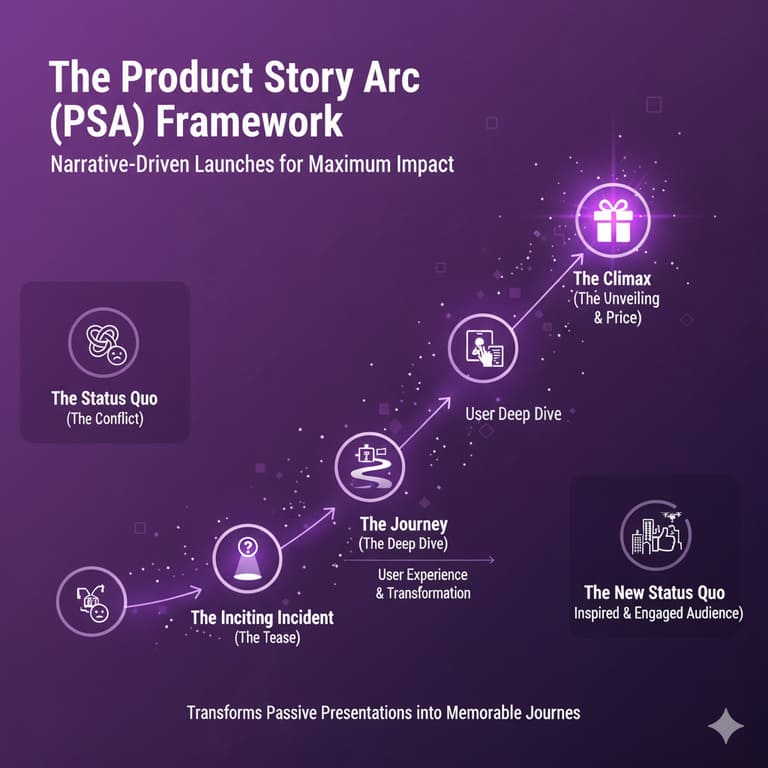
Product launches often fail because they focus too much on what the product is and not enough on the transformation it offers. The PSA framework borrows from narrative theory to structure the entire event flow.
- The Status Quo (The Conflict): The event opens by acknowledging the attendee’s current pain point, the market inefficiency, or the “old way” of doing things. *(*Highlighting the problem the audience can relate to.)
- The Inciting Incident (The Tease): A subtle, dramatic hint that a solution is coming. (A powerful 30-second teaser video or a cryptic speaker introduction.)
- The Journey (The Deep Dive): The core presentation, focusing not on features, but on the user experience and the transformation. (Live, interactive demonstrations and testimonials.)
- The Climax (The Reveal): The grand unveiling of the product, its price point, and its immediate availability. This must be the most impactful, visually stunning moment.
- The New Status Quo (The Future): A vision of the world with the product, leaving the audience inspired and ready to engage. (A closing keynote focusing on long-term impact.)
See More: The 3-Step Media Strategy Your Singapore Corporate Event Organizer Must Master
4. The Audience Segmentation & Journey Mapping Framework
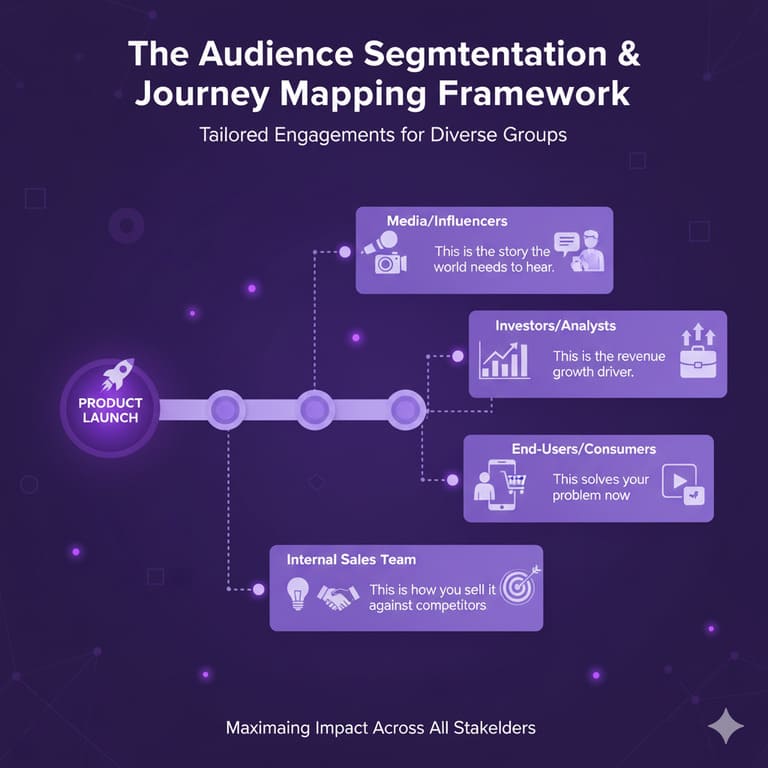
In Singapore, launches often target diverse groups: media, investors, end-users, and internal sales teams. Treating them all the same is a strategic mistake.
| Audience Segment | Required Touchpoint/Activity | Key Message |
| Media/Influencers | Exclusive briefing room; Hands-on product experience zone. | “This is the story the world needs to hear.” (Focus on novelty and market disruption.) |
| Investors/Analysts | Closed Q&A session with C-Suite; Detailed financial projection handout. | “This is the revenue growth driver.” (Focus on market share and profitability.) |
| End-Users/Consumers | Interactive demo stations; Tutorial videos; Immediate purchase/sign-up opportunity. | “This solves your problem now.” (Focus on utility and ease-of-use.) |
| Internal Sales Team | Dedicated pre-launch training; Q&A on competitive landscape. | “This is how you sell it against competitors.” (Focus on features, benefits, and sales scripts.) |
An effective event planning company Singapore uses venue space and time to create these tailored micro-experiences within the larger event.
5. The Risk & Contingency Tiers (RCT) Framework
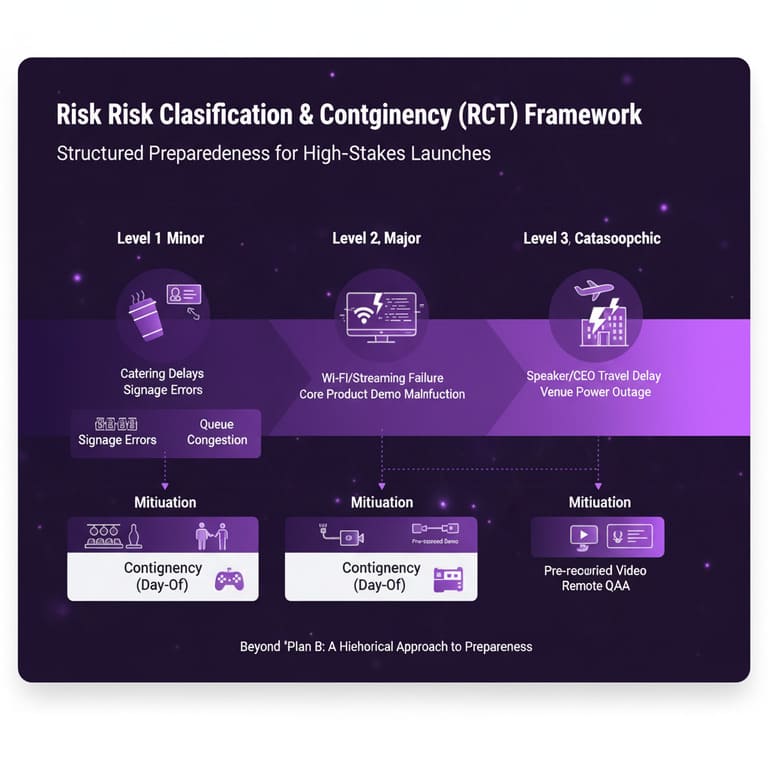
High-impact launches carry high risk. The RCT framework moves beyond simple “Plan B” to a structured, tiered contingency system.
| Risk Tier | Description | Mitigation Strategy (Pre-Event) | Contingency (Day-Of) |
| Tier 3 (Catastrophic) | Keynote Speaker/CEO travel delay; Venue power failure. | Double-booked backup keynote; Secondary venue/backup generator confirmation. | Immediate shift to virtual broadcast/pre-recorded keynote with live Q&A by a backup executive. |
| Tier 2 (Major) | Wi-Fi/Streaming failure; Core product demo glitch. | Hardwired internet redundancy; Offline demo environment/pre-recorded, polished demo video ready. | Activate hardwired backup; Announce pre-recorded video presentation while fixing the live system. |
| Tier 1 (Minor) | Catering delay; Signage error; Queue congestion. | Over-staffed F&B stations; Detailed wayfinding staff briefing; Digital signage backup. | Deploy floaters/ushers to manage traffic; Offer small engagement activities during delays. |
See More: How to Plan an Unforgettable Awards Ceremony That Inspires Your Team
6. The Omnichannel Content Nurturing (OCN) Framework
The event is a source, not the end, of content. The OCN framework ensures maximum digital longevity and reach, maximizing the investment.
- Pre-Event Content (Tease & Ticket): Short-form video snippets, speaker highlights, and polls used to drive registration and build anticipation.
- Live Content (Capture & Stream): Professional multi-camera streaming, live social media updates, and on-the-spot interviews optimized for immediate sharing.
- Post-Event Content (Nurture & Convert): Breaking down the core presentation into 10-15 bite-sized videos, detailed white papers, and follow-up email campaigns tailored to the audience segments.
A forward-thinking event planning company Singapore integrates a dedicated content capture team as a primary part of the launch budget.
7. The Vendor and Supplier Integration (VSI) Framework
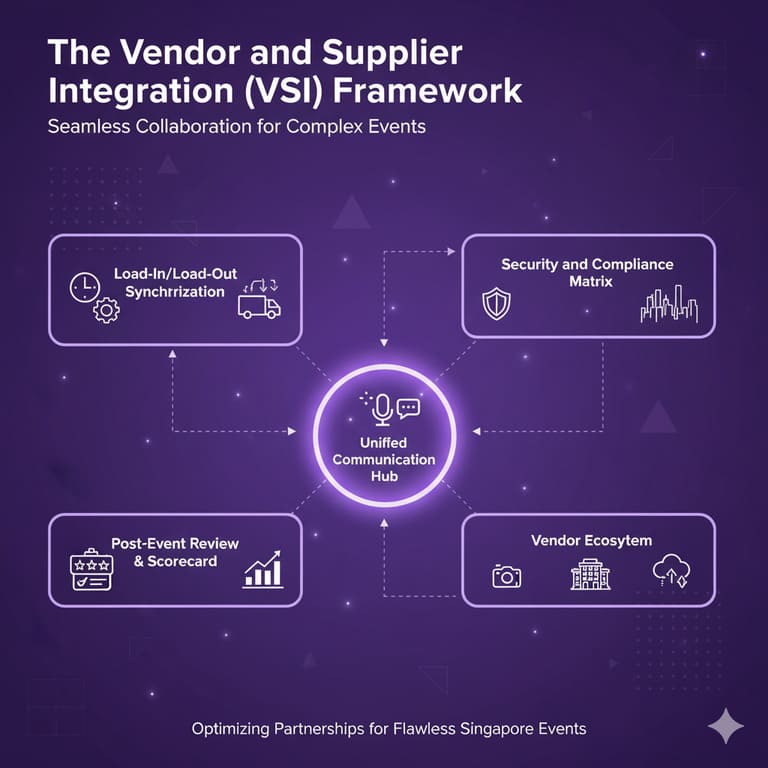
In a complex market like Singapore, managing multiple high-end vendors (AV, catering, venue, digital tech) requires a unified framework, not just a list of contacts.
- Unified Communication Hub: All vendors must report to a single project manager from the event planning company, using a shared platform for real-time updates and issue logging.
- Load-In/Load-Out Synchronization: Rigorous scheduling ensures no vendor interferes with another, minimizing downtime and maximizing setup efficiency (crucial in high-demand Singapore venues).
- Security and Compliance Matrix: A shared document outlining venue regulations, emergency protocols, and specific insurance requirements, ensuring all parties are compliant with local Singapore laws.
- Post-Event Review & Scorecard: A standardized scoring system for vendor performance used by the event planning company Singapore to continuously refine their preferred partner ecosystem.
See More: Save $1000 Instantly: The Smart Way to Choose Your Corporate Event Planner in Singapore
Frequently Asked Questions (FAQs) about Event Planning Companies in Singapore
Here are 8 common and deep-level questions clients often ask when engaging with an event planning company Singapore:
1. What specific regulatory and compliance factors in Singapore must an event planner be expert in?
A highly capable event planning company Singapore must be adept at handling permits from various bodies, including the Singapore Police Force (for public assemblies/street closures), Singapore Civil Defence Force (SCDF) regulations for fire safety and venue capacity, and intellectual property/licensing laws for music and content usage. For food events, hygiene standards set by the Singapore Food Agency (SFA) are non-negotiable.
2. How does an Event Planning Company Singapore integrate sustainable (Green MICE) practices into corporate events?
A strategic planner moves beyond simple recycling. They employ Green MICE practices by sourcing F&B from local, sustainable vendors, minimizing paper use via digital event apps, designing reusable set elements, tracking and offsetting carbon footprint from attendee travel, and prioritizing venues with certified green ratings.
3. What is the standard fee structure for event planning services in Singapore (e.g., percentage, flat fee, or hybrid)?
Fee structures typically fall into three categories: a Percentage of Total Spend (common for large-scale, complex events, typically 10-20%); a Fixed Management Fee (common for projects with clearly defined scopes and budgets); or a Hybrid Model (a fixed base fee plus a smaller percentage of variable costs). Transparency on vendor markups is a key differentiator for top-tier firms.
4. Beyond venue sourcing, what value does a top-tier Singapore Event Planning Company add during the pre-event stage?
Their value lies in strategic counsel: they conduct SWOT analysis specific to the event’s market, develop the core narrative and messaging (not just the design), provide budget optimization by leveraging preferred vendor rates, and establish the measurement KPIs directly linked to business outcomes.
5. How do Singapore Event Agencies leverage technology for maximum attendee engagement?
Modern agencies utilize sophisticated tools such as AI-powered networking platforms (matchmaking attendees based on interests), augmented reality (AR) product demonstrations, live polling and Q&A systems during keynotes, and integrated event apps for personalized agendas and post-event content delivery.
6. What is the typical lead time required to plan a major product launch event in a prime Singapore venue?
For a major, high-impact product launch utilizing a premier venue (like Marina Bay Sands or Suntec Singapore), a lead time of 6 to 12 months is typically required. This accounts for securing the best dates, navigating permit processes, custom fabrication of stage sets, and aligning global marketing campaigns.
7. What are the key considerations for hosting a successful hybrid event in Singapore?
Success hinges on treating the virtual audience as a distinct segment (Framework #4). Key considerations include dual production crews (one for the physical room, one for the broadcast), dedicated digital hosts to manage online Q&A/chat, ensuring low-latency streaming infrastructure, and offering unique virtual content not available to in-person attendees.
8. How does an Event Planning Company Singapore ensure brand consistency across international teams for a global launch?
They enforce a strict Brand Playbook, detailing every visual and verbal element, manage communication across all international marketing and PR teams, and often host “Train the Trainer” sessions to ensure all regional spokespeople deliver the core product narrative with perfect consistency.
See More: How Much Does It Cost to Hire an Event Management Company in Singapore?
Choosing Your Strategic Launch Partner
A product launch is a complex, high-stakes endeavor that requires precision, creativity, and—most importantly—strategic depth. By understanding the seven frameworks utilized by Singapore’s leading planners, you can move past superficial details and focus on the partnership that will drive measurable business success.
When evaluating an event planning company Singapore, look for one that doesn’t just ask “What is your budget?” but asks “What are your post-launch KPIs?” This strategic mindset is the definitive marker of a firm equipped to execute a high-impact, successful launch event.
Elevate Your Next Launch with iCreationsLAB
At iCreationsLAB, we don’t just plan events; we architect experiences built on strategic frameworks designed for maximum business impact. Our team in Singapore specializes in leveraging advanced analytics, experiential design, and comprehensive risk mitigation to ensure your product launch isn’t just an announcement, but a seismic shift in your market.
Ready to transform your next product introduction into a landmark business success? Partner with iCreationsLAB and let us apply our data-driven strategic expertise to your brand’s biggest moment.
Contact iCreationsLAB today to discuss your high-impact product launch strategy.